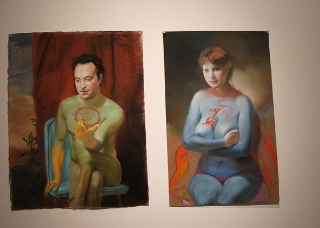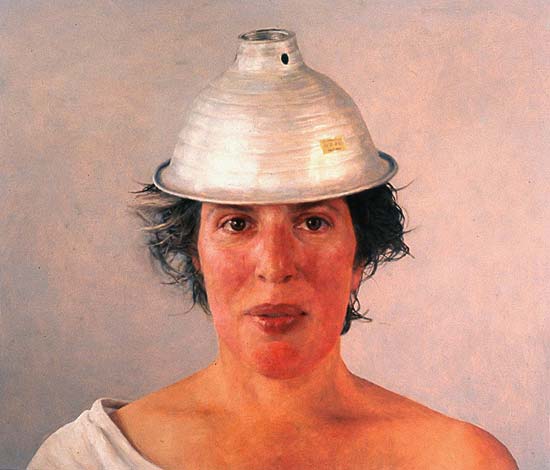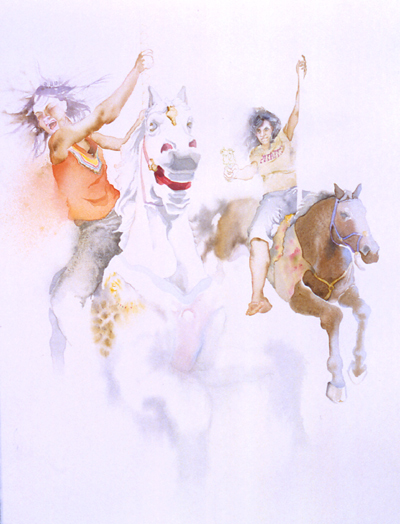Another work by David Gremard Romero:
"______"

New art in the collection includes two new pastel pieces by DAVID GREMARD ROMERO.
"Super Heros"

ESSAY ON ROMERO:
David Gremard Romero: Metamorphosis
essay by Jacqueline Cooper
David Gremard Romero’s paintings and drawings are redolent of Classical allegory and executed in a technique that recalls the late Renaissance and the subtle nuances of Mannerist portraits. Throughout this body of work, figures, or characters, are depicted in the throes of transfiguration. In the paintings and pastels on paper this metamorphoses remains incomplete, whereas in the drawings the completed
transformation propels a specific narrative.
Taking his cue from the classical tradition of patronage when artists depicted their benefactors as allegorical figures, David began his series of paintings and pastels by asking his models to describe the characteristics, spiritual, moral or otherwise, of a super ego that might be representative of their own projected desire. Some of the models were specific while others were vague. The site, or stage setting, for these transformations is frequently modeled on the Elysian fields of Rococo landscape
painting. Loosely brushed-in trees sit in front of pale washes of color, while the confident brushwork and strident colors of the fi gures occupy the foreground. Romero usually refers to the partially transformed selves as “Superheroes”. This further distances the figures from their backgrounds and suggests a character actor free to explore and exchange archetype, gender, race and sexuality as he/she adopts, tentatively, or otherwise, the costume of an “other’ freed from the subjectivity of history or environment. This obviously makes some of his models uncomfortable. For example, in the painting, Portrait of Heather as a Superhero Unmasked, the model seems unsure of the protection of her luxurious purple cloak, and clings to a black mask in her hand as if the vulnerability of her disguise had just been penetrated. Other portraits, however, celebrate the autonomy of their chosen transformation.
In the luscious pastel on paper, Transformation of Migs into a Superhero, the figure turns his head away from the gaze of the viewer but puffs out his chest with pride while his red, blue and gold tunic strains to wrap his naked torso. A proud coquette, Migs dares the viewer to comment on the intimacy of his personal metamorphoses. Not all the archetypes chosen by the models are esoteric. One of the
most dignified of transformations is seen in the work, David Rudolph as the Lumberjack. The slightly elongated figure whose red and black flannel shirt is opened in a state of partial undress represents a noble personification of the mythical, axe-bearing, woodsman.
As the transformations become more extreme and complicated, the artist increasingly flirts with gesture and form by liberating the figures from the pedantic needs of human anatomy. This is most obvious in the work Self-Portrait as Wonderwoman with Linda Carter as Diana Prince. Using himself as subject, Romero has squeezed and attenuated his own form into an awkward but defiant depiction of the actress Linda Carter’s television “Wonderwoman”. A spectacle in itself, this transgendered deity
clutches a portrait miniature of the original DC Comics Wonderwoman, Diana Prince. This cameo is a fetish that can only be approximated through the adoption of a recognizable but rather ridiculous costume. In this work, David Gremard Romero suggests that the authority suggested by physical transformation relies on the popular recognition of costume, whereas the subject as allegorical figure has to further refer to heroic ideals and political agency.
The theme of metamorphosis as a medium for personal and political change is followed through in a group of sequential drawings, arranged as a frieze that partially wraps around the gallery walls. Hung at eye level and reading from left to right, this work is an homage to Ovid’s Metamorphosis. The form and scale of Romero’s narrative drawing is comparable to a graphic novel or the preliminary storyboarding of epic cinematography. A storyboard outlines direction in the production of a film and,
similarly, the frieze has changes of pace and focus throughout its length. Individual characters are focused on when specific physical transformations mark a paradigm shift. In one frame two figures exchange eyeballs, while in another, open mouths feed aggressively on the fecund figure of a multiply breasted woman. By contrast, when the collective actions of characters provide the impetus for social
revolution, the sweep of the artists’ lens is appropriately wide. The storyline in Romero’s work loosely mirrors Metamorphosis but remains open-ended with conclusions being drawn only about victory over past physical and psychological lives when, for example, groups of figures shed brown skins for blue, or characters elect gender as a refl ection of the predominant show of force. Ovid’s Metamorphosis is anachronistic and, similarly, David Gremard Romero plays with this idea by introducing contemporary iconography to suggest the mutability of present day subcultures. He characters are pushedinto the foreground by flat colors and the graphic division of the space behind them. The flattened perspective of the comic strip environment is further accentuated in one frame where the artist has adopted a cartoons, blossom patterned print as a metaphor for the (already once-removed) illustrated realism of branches and flowers. This gesture is reminiscent of backgrounds in Japanese manga and anime, this element subtly contradicts the overarching Classical content.
As well as the large narrative drawing and the paintings and pastels, single cartoons are also on display in the gallery. These works are more ironic, positioning themselves as a bridge between the allegorical portraits and the fast paced graphic novel. Their composition frequently references sketches by Michelangelo or Tiepolo, although the angels and gargoyles are ripped from the pages of contemporary comics and dysfunctional Superhero couplings occur between the cast-offs from Marvel comics. In the paintings, although the figures remain passive, costume and symbol provide clues to events offstage. In the frieze, as in the cinema, action is present and continually unfolding as a narrative offered to a passive viewer. Although the paintings present the transformation of character into archetype by the adoption of theatrical costume and the drawings describe acts of heroism and selfsacrifice, David Gremard Romero refers to the lineage of classical narrative in both forms. In doing so he provides the viewer with access to allegory as he attempts to elevate the human condition through the loving act and attention of painting and drawing.
New piece by JENNY DUBNAU.
http://www.re-title.com/artists/jenny-dubnau.asp
"M. wearing lampshade as helmet"

ARTIST'S STATEMENT: "My work attempts to describe momentary encounters with people. Using photography as a starting point, I hold a photo shoot with a friend, and see what occurs between us. I usually choose the image which is the most revealing: it is often also the image which renders the subject the most vulnerable, both psychologically and physically. Photography can capture “in-between” moments of great awkwardness; painting can extend the length of those moments, creating a context in which metaphors of mortality and grace can be extracted out of the imperfections and physical flaws of the subjects."
Another new piece is by LAURA BALL.
"Pirates"

MICHAEL KISER REVIEW OF LAURA BALL SHOW AT PETER MILLER GALLERY
The young women in Laura Ball’s new paintings appear exnihilo, as though inexplicably transported from their daily grind into a utopian jungle where horses, rams, and lemurs await a playful battle.
Showing both oils and watercolors, Ball displays the breadth of her talents. The canvas works recall Sigmar Polke’s sketchy, disappearing figures, but with more focus and direct narrative.
Her delicate watercolors demonstrate her craftsmanship and restraint. The natural rendering of the girls and animals contrasts with other water-thinned elements breaking apart into abstract areas of hazy color. Each figure maintains a weight and solidity in their airy, vacant environment, which gives them the feeling of dreams or wild visions. They seem to bleed through the empty fibers of the paper and into our world.
Armed with squirt-guns and pointed fingers, and atop the unusual work animals, the girls engage in a brightly colored chaos that ranges from light, ironic glee, to a darker, unexpected violence. These are not the simple fantasies of little girls, carrousels and candy, but those of a slightly older, not yet settled age when fear and responsibility begin to claim the minds of young people.
Here, the only realities will be manufactured by the inhabitants. The girls’ excitement seems uncontrollable. Their arms flailing, legs kicking off the sides of horses, and laughing so hard it must hurt, they are clearly releasing a pent-up cache of energy and creativity. Their newfound freedom implies a prior oppressor, and the mostly negative space into which these dream-like renderings emerge hint at an external absence.
With this oppressor confined to the blank margins of the page, there remains no hindrance to the ultimate enjoyment of the girls. Except themselves of course. The dissonance created between their formerly internal and external realities falls. And where much responsibility is given, failure is rampant. The girls are affected by this “play” in extremely different ways. Many seem emotionally distraught and victimized.
Whatever their individual oppressors in the real world, they have clearly not escaped them all. They project their own fears onto each other, as they are clearly not endangered by squirt-guns or search parties with walkie-talkies. And others seem to be putting too much threat behind these same toy weapons, grimacing as they pull the imaginary triggers.
The difficulty for some of these girls seems to lie in their inability to understand why they still feel afraid in their collective fantasy. If they feel fear, then there must be someone to be afraid of. And without the boring job to hate, or the overbearing parents, these young women seem to be in the throws of their own developing, and sometimes self-destructive psychology.
—Michael Kiser [mkiser@sedaqa.org]
--------------------------------------------------------------------------------
Laura Ball: Wargames (Don't Try This At Home)
Peter Miller Gallery, Chicago
Oct 20—Nov 25, 2006
www.laurasgallery.com
www.petermillergallery.com
